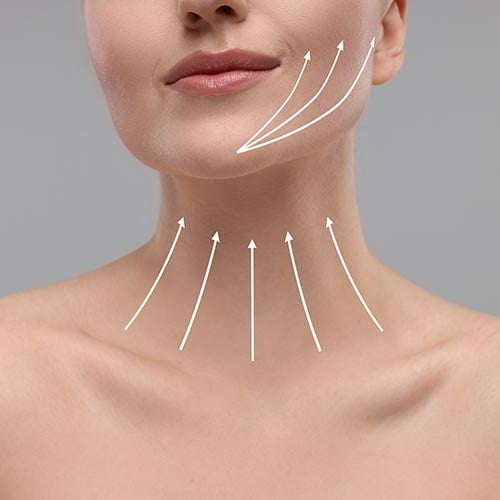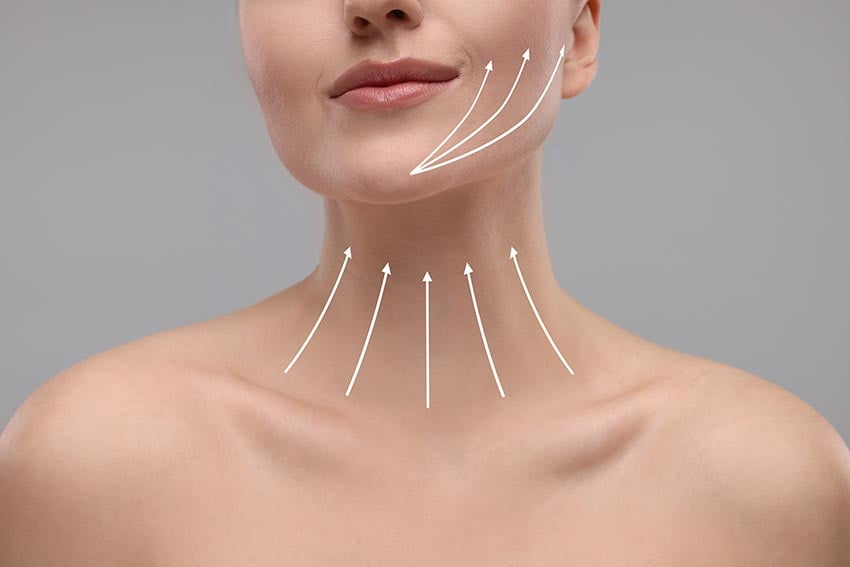Steps to Take During the Recovery Process After a Neck Lift Surgery
The recovery process is crucial for individuals undergoing neck lift surgery and may raise many questions. There are numerous details to consider after the procedure to ensure proper healing. In this blog post, we will answer all your questions regarding the post-operative recovery process for neck lift surgery.


İÇİNDEKİLER
How Long Can Neck Pain Be Expected After Surgery?
Post-operative neck pain can be a concern for patients undergoing neck lift surgery. However, each procedure has a unique recovery process, and the level of pain experienced can vary from person to person. Typically, mild to moderate pain and discomfort in the neck area are normal during the first few days after surgery. It is essential to take the prescribed pain relievers as directed by your doctor during this period. Pain generally subsides within a few days and may completely disappear depending on the individual.
Mild discomfort or pain may still be present during the first week post-surgery, which is considered normal. During this time, it is crucial to rest, get sufficient sleep, and continue using pain medications as recommended by your doctor. Engaging in stress-relieving activities can also be helpful for managing post-operative pain. Especially in the initial days when physical activity is limited, techniques like relaxation exercises and breathing practices can aid in alleviating discomfort.

What Activities Should I Avoid to Speed Up the Recovery Process?
The recovery process is the time required for the body to regain its healthy state after surgery. Choosing the right activities and avoiding harmful ones are crucial for accelerating healing. Knowing which activities to steer clear of can significantly impact your post-operative recovery.
The first activity to avoid is excessive physical exertion. To allow your body to heal fully, you should refrain from intense physical exercises, particularly those involving heavy lifting, as these can hinder the healing of wounds and potentially cause further damage. It’s essential to reduce the intensity of your physical activities during the recovery period.
Is Swelling and Bruising Within the First Few Days Normal?
Swelling and bruising within the first few days are common and expected side effects after most surgical procedures. These occur as natural responses of the body. During surgery, manipulation and incisions made to the tissues beneath the skin can temporarily damage blood vessels, leading to swelling and bruising.
Swelling and bruising are typically most pronounced in the first few days and gradually diminish over time. As the tissues under the skin heal and blood vessels repair themselves, the discoloration will fade progressively.
If you experience severe swelling, excessive bruising, or intense pain during this period, it’s important to contact your doctor immediately. Such symptoms could indicate unusual or concerning issues that might require specific medical attention.
What Procedures Are Involved in Wound Care?
Post-operative wound care is crucial for accelerating recovery and minimizing the risk of infection. Follow these instructions to ensure proper wound care:
Cleaning and Dressing the Wound: Keep the wound clean and dry. Clean it daily with sterile water or a recommended antiseptic solution. Change the dressing daily, and monitor the wound for any signs of infection, such as redness, swelling, or discharge.
Choosing and Using Dressings: Select a dressing that matches the size and shape of the wound. Apply it carefully over the wound without applying excessive pressure. Replace the dressing if it loses its adhesiveness or becomes dirty.
During the Healing Period: Avoid strenuous activities, heavy lifting, and sports until the wound has healed. Adhere to your doctor’s instructions for optimal recovery. If you have questions or concerns about wound care, consult your doctor promptly.
What Side Effects Might I Experience in the First Few Days?
Headaches are a common side effect experienced by many individuals after surgery. These may result from anesthesia, surgical stress, neck positioning, or medication side effects.
However, it’s essential to note that headaches can sometimes indicate a more serious issue. If your headache is severe or accompanied by symptoms such as nausea, vomiting, or fever, contact your doctor immediately.
For most patients, post-operative headaches are mild and temporary. During this time, rest and avoid activities that may strain your body. Pain relief medications, as prescribed by your doctor, can help manage discomfort effectively.

How Should I Regularly Take My Medications and What Pain Relievers Can I Use?
There are two primary methods for managing post-operative pain: consistent medication use and pain relievers. Your doctor will provide detailed instructions about the medications you should take. It is crucial to follow these instructions closely and take your medications regularly without missing any doses. This helps keep pain under control.
For pain relief after surgery, several types of painkillers may be recommended:
- Paracetamol: This is one of the most commonly used painkillers and can effectively reduce mild to moderate pain.
- Other Pain Relievers: Your doctor may also prescribe additional medications based on your specific needs. Carefully follow the dosage and frequency guidelines provided by your doctor.
It is essential to avoid overusing painkillers and take them exactly as prescribed. Overuse or long-term use of painkillers can lead to side effects such as stomach discomfort, bleeding, kidney problems, or dependency. Maintain regular communication with your doctor, and report any adverse effects immediately.
When Will My Stitches Be Removed, and How Does the Process Work?
One of the common concerns after a surgical or aesthetic procedure is determining when the stitches will be removed and how the process works. The timing depends on the surgical site and the type of procedure performed. For surgeries on the face and neck, stitches are typically removed within 5 to 7 days.
The removal process is planned and carried out by your doctor. Since every surgical procedure has its unique healing timeline, the exact timing for stitch removal may vary accordingly.
Stitch removal is usually painless. However, some patients might feel slight discomfort. Your doctor will ensure that the process is quick and smooth, minimizing any potential unease. Always follow your doctor’s aftercare instructions to support proper healing and recovery.
When Can I Resume Activities After a Neck Lift Surgery?
Boyun germe operasyonu sonrasında iyileşme süreci kişiden kişiye değişebilir ve cerrahi müdahalenin ciddiyetine bağlı olarak farklılık gösterebilir. Bu nedenle, spesifik bir duruma ve operasyonun detaylarına göre kesin bir zaman çizelgesi belirtmek zordur. Ancak genel olarak, boyun germe operasyonu sonrasında aşağıdaki aktivitelere dönmek için belirli bir süre beklemek tipik olabilir:
Hafif Aktiviteler
- Yürüyüş gibi hafif egzersizlere genellikle operasyondan birkaç gün sonra başlanabilir. Ancak bu, cerrahi prosedürün karmaşıklığına ve kişisel sağlık durumuna bağlı olarak değişebilir.
Ağır Egzersiz ve Sporlar
- Cerrahi müdahalenin ciddiyetine bağlı olarak, ağır egzersizlere ve spora dönmek birkaç hafta veya hatta birkaç ay sürebilir. Cerrahi ekibinizin talimatlarına ve kontrollerine uymak önemlidir.
İşe Dönme
- Hafif ofis işleri gibi oturma pozisyonunda çalışma durumlarına birkaç hafta içinde dönülebilir. Ancak ağır fiziksel işlerde çalışanlar için bu süre daha uzun olabilir.
Araba Kullanma
- Boyun hareketliliği ve rahatlık düzeyine bağlı olarak, operasyondan sonra birkaç gün veya hafta sonra araba kullanmaya başlamak mümkün olabilir.
Yük Taşıma
- Ağır yükleri kaldırmaktan kaçınmak genellikle ilk birkaç hafta önemlidir. Cerrahi ekibinizin önerilerine uymak, iyileşme sürecinizi hızlandırabilir.
Her hasta farklıdır ve cerrahi sonrası iyileşme süreci bireysel faktörlere bağlı olarak değişebilir. Bu nedenle, cerrahi ekibinizin önerilerine ve takip randevularına düzenli olarak uymak önemlidir. İyileşme sürecinizde herhangi bir sorun yaşarsanız, derhal cerrahınıza başvurmalısınız.
What Activities Can I Resume After a Neck Lift Surgery?
The recovery process after a neck lift surgery can vary from person to person and depends on the severity of the surgical intervention. Therefore, it is difficult to provide a specific timeline, as it depends on the individual’s condition and the details of the surgery. However, generally, the following timeframes are typical for resuming certain activities after a neck lift surgery:
Light Activities
Light exercises such as walking can generally be started a few days after surgery. However, this may vary depending on the complexity of the procedure and the individual’s health condition.
Heavy Exercise and Sports
Depending on the seriousness of the surgical intervention, returning to heavy exercises and sports may take several weeks or even months. It is important to follow the instructions and check-ups from your surgical team.
Returning to Work
Light office work, where sitting is required, can usually be resumed within a few weeks. However, for individuals with physically demanding jobs, this period may be longer.
Driving
Depending on your neck mobility and comfort level, you may be able to start driving a few days or weeks after the surgery.
Lifting Heavy Objects
Avoiding heavy lifting is usually important for the first few weeks. Following your surgical team’s recommendations can help speed up your recovery.
Each patient is different, and the recovery process can vary based on individual factors. Therefore, it is important to consistently follow the recommendations of your surgical team and attend follow-up appointments. If you experience any issues during your recovery, you should immediately consult your surgeon.
When Can I Start Physical Activity and Exercise?
Each individual’s recovery process can differ, so it is difficult to provide a general timeline. However, after most aesthetic surgeries, it is recommended to avoid physical activities for several weeks. During this time, you allow your body to rest and focus on healing. Your doctor will provide surgery-specific instructions, so it is important to follow these instructions carefully.
Exercise helps strengthen your body and improve flexibility. However, due to potential strain or complications caused by certain exercises after surgery, it is important to get approval from your doctor before starting any physical activity.
When Will I See Significant Improvement in My Appearance After a Neck Lift?
Significant improvement in appearance can start to become noticeable within the first few weeks after surgery. However, it may take longer to see the full results. Generally, patients can achieve the desired results within 3 to 6 months after surgery.
The speed and extent of improvement after a neck lift depend on various factors. These include the patient’s age and skin type, the technique used during the surgery, the surgeon’s experience, and how well the patient follows the recovery process. Therefore, it is not correct to expect the same recovery timeline for everyone.
However, with careful post-operative care and proper healing practices, faster improvement can be achieved. It is important to follow post-surgery instructions closely and adhere to the doctor’s recommendations. Be cautious with wound care, medication usage, and physical activities.
Special Materials to Support the Head and Neck Area
During the recovery process, supportive pillows help maintain the correct position of the neck and head. These pillows are designed to support the neck and reduce pressure on the shoulder and back areas. There are various options available, depending on the firmness and shape. Special pillows that support the head and neck help you stay in the proper position while sleeping and accelerate healing.
In addition, there are different materials that can be used to support the head and neck area. For example, you can use a soft and comfortable neck brace. The neck brace supports the neck muscles and restricts movement. This helps support the healing process without putting excessive pressure on the neck area.
What Complications May Arise During the Recovery Process?
Like any surgical procedure, neck lift surgery can come with potential complications. Although most of these are rare, it is important to act cautiously and take the right precautions.
Infection
There is always a risk of infection after surgery. If you notice signs of infection, such as redness, swelling, pain, or discharge at the surgical site, contact your doctor immediately. To minimize the risk of infection, you should carefully follow the post-surgery wound care instructions.
Bleeding
Although bleeding during surgery is rare, it is important to be cautious. If you notice signs of bleeding, such as severe pain, intense bruising, or continuous discharge from the wound, inform your doctor right away. To reduce the risk of bleeding during the post-operative period, avoid using blood-thinning medications or substances that prevent blood clotting.
Wound Healing Issues
Post-surgery wound healing may sometimes cause issues. If you experience problems such as wound opening, fluid buildup at the wound site, or infection, you should consult your doctor. Carefully follow the wound care instructions and adhere to your doctor’s guidance to support the healing process.
Nerve Damage
While nerve damage during surgery is rare, there is a risk of this complication. If you experience symptoms such as numbness, tingling, weakness, or difficulty with muscle control, contact your doctor immediately. The best way to prevent nerve damage is to have the surgery performed by an experienced plastic surgeon.
Anesthesia Reactions
Although allergic reactions or side effects to the anesthesia used during surgery are rare, they are a potential risk. If you experience difficulty breathing, wheezing, or severe headaches, inform your doctor immediately. It is important to share any known allergies to anesthesia with your doctor beforehand to minimize potential risks.
How Does Smoking Affect the Recovery Process?
Smoking is a harmful habit that can lead to many health issues. After surgery, smoking can negatively affect the recovery process following a neck lift. The chemicals in cigarettes reduce oxygen-carrying capacity, which hinders tissue regeneration and slows down wound healing. Additionally, smoking can increase the risk of infection.
Quitting smoking can positively impact the recovery process. First, quitting smoking accelerates tissue regeneration and supports wound healing. It also improves lung function and helps the respiratory system work more efficiently. This allows more oxygen to be transported throughout the body, which speeds up healing.
It is important to consult with your doctor before quitting smoking. Your doctor can assist you with a smoking cessation program or treatment options. Additionally, it is important to seek emotional support during the process of quitting. Joining support groups or consulting a counselor can provide motivation and support as you quit smoking.